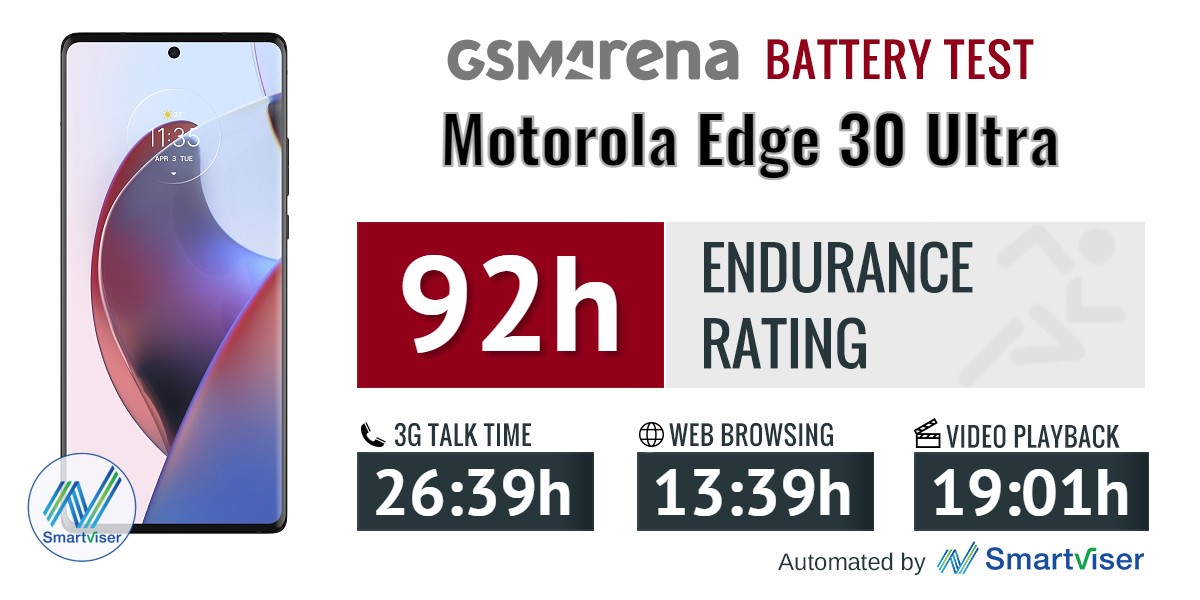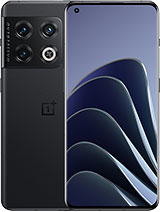Introduction
The name is familiar - Motorolas with Edge 30 in their names have been around since the start of the year. But the Edge 30 Ultra is part of the latest batch of three models announced for the world just last week, and it's the top-of-the-line one. Let's see what it's all about.

But first - some more nomenclature. As is normally the case, a smartphone already available in China under a different name is the Edge 30 Ultra's alter ego - the Moto X30 Pro. At this point, we don't think there are plans for availability in North America, but if past experience is any indication, there will likely be another name for essentially the same phone there (again, if the phone does make it to North American markets).


Motorola Edge 30 Ultra • Motorola Moto X30 Pro
Back to the Edge 30 Ultra. The phone boasts some big numbers in multiple areas, starting with the 200MP main camera - the first implementation of that sensor that makes it to our doorstep. And that's not all, of course - keeping it company is a 50MP ultrawide with autofocus, and a telephoto, albeit more modest with the specs (2x, 12MP). The selfie camera brings us back into the megapixel race with its 60MP resolution.
One-upping the competition in another numbers game, the Edge 30 Ultra's display can refresh at up to 144Hz - not a first for a Moto, but hardly common outside of gaming phones. Also impressive is the charging power rating - the handset supports 125W charging and comes bundled with an adapter that can match it.
As Motorola's flagship of sorts, the Edge 30 Ultra is powered by the latest top-level Snapdragon (8+ Gen 1), and it has plenty of oomph to facilitate the 'ready for' functionality - Motorola's take on a desktop experience driven by your phone. Mainstream niceties like stereo speakers, wireless charging, and an under-display fingerprint sensor are also present, but the IP52 rating leaves us wanting more - Motorola could have made the extra effort for proper water resistance on a phone that starts at €900.
Motorola Edge 30 Ultra specs at a glance:
- Body: 161.8x73.5x8.4mm, 199g; Glass front (Gorilla Glass 5), glass back (Gorilla Glass 5), aluminum frame.
- Display: 6.67" OLED, 1B colors, 144Hz, HDR10+, 1250 nits (peak), 1080x2400px resolution, 20:9 aspect ratio, 395ppi.
- Chipset: Qualcomm SM8475 Snapdragon 8+ Gen 1 (4 nm): Octa-core (1x3.19 GHz Cortex-X2 & 3x2.75 GHz Cortex-A710 & 4x1.80 GHz Cortex-A510); Adreno 730.
- Memory: 128GB 8GB RAM, 256GB 8GB RAM, 256GB 12GB RAM, 512GB 12GB RAM; UFS 3.1.
- OS/Software: Android 12.
- Rear camera: Wide (main): 200 MP, f/1.9, 1/1.22", 0.64µm, PDAF, OIS; Telephoto: 12 MP, f/1.6, 1.22µm, PDAF, 2x optical zoom; Ultra wide angle: 50 MP, f/2.2, 114˚, 1/2.76", 0.64µm.
- Front camera: 60 MP, f/2.2, (wide), 1/2.8", 0.61µm.
- Video capture: Rear camera: 8K@30fps, 4K@30/60fps, 1080p@30/60/120/320/960fps, gyro-EIS, HDR10+; Front camera: 4K@30fps, 1080p@30fps.
- Battery: 4610mAh; Fast charging 125W, Fast wireless charging 50W, Reverse wireless charging 10W.
- Misc: Fingerprint reader (under display, optical); NFC; stereo speakers.
Motorola Edge 30 Ultra unboxing
The Edge 30 Ultra ships in Motorola's newly adopted packaging that's entirely plastic-free. The sturdy two-piece recycled cardboard box works just as well as a fancier enclosure but comes with a lower carbon footprint.

The contents of our retail bundle include a 125W TurboPower adapter, a USB-C cable, and a clear protective case. The phone itself has a pre-applied screen protector too. Both are included in select countries, though, so don't be too surprised if your Edge 30 Ultra ships without one or both of them. Similarly, some countries will get a USB-C headset - missing in our box.
Design, build quality, handling
The word 'edge' used to mean something at the dawn of curved display panels and later in Motorola's lineup - the original Motorola Edge from 2020 had sloping display sides. Subsequent models turned flat, however, keeping the name to maintain continuity in the lineup. Well, the Edge 30 Ultra goes back to the roots and reintroduces the curved display.

A curved display is one of those traits that bring an air of exclusivity and expensiveness to any phone, and the Ultra certainly feels premium. The edge display has minimal borders on the sides, yes, but also above and below it, making for a refined, flagship-grade presentation.

We did encounter the occasional lapse in mistouch prevention - the bane of curved screens. Oddly enough, that only happened in artificial situations while posing for the lifestyle photos and not in actual operation by this one reviewer. It's one of those things that tends to be fairly personal and may or may not show up in your experience, depending on usage specifics.

The top of the Gorilla Glass 5 front panel has a slit chiseled for the earpiece, and the earpiece also doubles as a second speaker - directed only towards the front. The selfie camera cutout below that is looking pretty small and certainly doesn't remotely hint at the number of pixels underneath.

Also made of Gorilla Glass 5 is the rear panel, but it's finished differently. It's got an antiglare treatment, so it's not at all glossy, which makes it very resistant to accumulating fingerprints.
The flipside to this frosted surface is that it's particularly slippery, but this isn't unique to the Edge 30 Ultra, and we'd say it's on the right side of the trade-off.

While the rear panel can look pretty mundane under most circumstances, especially so on our Interstellar Black review unit, if you were to take it out in the sun, it sparkles like it's covered in glitter, an effect we've seen on a number of other phones recently, and one we kind of like.

The other color option goes by Starlight White and has the same finish, so it's identical to the touch. The glittery effect does tend to be a little more pronounced, and it takes less intense light for it to show through.
Regardless of colorway, the Edge 30 Ultra has the same IP52 rating for dust and water resistance, and that's not very reassuring. Motorola says it should be good for 'accidental spills, splashes or light rain' but explicitly states it's not designed to be dunked in water. In a world where the Galaxy A53 has an IP67 rating and should be able to survive for 30 minutes under a meter of water, while costing a little over a third of the Edge 30 Ultra, Motorola's half-baked approach doesn't look good.

The back itself does, though. Motorola refrained from overdesigning things, and the rear is stylishly minimalistic. The 'accents' include the famed bat logo and a small 'motorola' badge down below, but there are no further distractions.
Admittedly, the camera island's three-stepped build may appear odd from some angles, but it was the designers' logical solution to accommodating the different cameras with their varying height requirements. The 200MP main unit takes the top spot, the other two are arranged symmetrically underneath, and there's not a whole lot of unnecessary text - just the key specs for the primary camera.

That protruding camera assembly does have the predictable downside that it makes the phone wobble if you try to type on it while it's resting on a table. But we dare say that the bump is more of a good thing than a nuisance because it raises the phone enough from the surface to make it easier to pick up.

Without that aid, it would be a little more fiddly to lift the Edge 30 Ultra - the otherwise premium aluminum frame is particularly thin at the sides as a result of the matching edge curvature front and back, and offers little gripping area. The frame can feel a little sharp in places, those places being the corners - it's somewhat scratchy where the corner of the handset meets the inside of your palm. It's hardly a dealbreaker, but it did come up.

The placement of the usual bits along the phone's perimeter doesn't bring any surprises. The power button and volume rocker are both on the right, and the very thinness of the side rail means the buttons themselves are pretty slim. The power button, in particular, is also rather short, but its knurled surface does help make it easier to locate.
All the regulatory texts you didn't see on the back are scattered on the bottom - out of sight where they belong. They do have to navigate some obstacles here - the USB-C port, main loudspeaker, primary mic, and card slot (dual nano SIM, no microSD) are here, as usual. On the far end, you'll only see a mic opening and a Dolby Atmos logo.



Buttons on the right • Familiar stuff on the bottom • Lone mic pinhole up top
The Edge 30 Ultra measures 161.8x73.5x8.4mm and weighs 199g, Motorola's specs read. It's taller (by 4.4mm) but narrower (by 2.3mm) than a Galaxy S22+, and it's marginally smaller in every direction than a OnePlus 10 Pro (though practically the same). The Galaxy is close to a millimeter thinner than the Moto, but the Moto's sloping sides and thin frame do make it subjectively more compact.

Of course, being a 6.7(-ish)-inch phone, the Edge 30 Ultra is best handled with two hands for any operations more complex than doomscrolling. The slippery back and thin sides don't help either, and a more deliberate application of the Neil deGrasse Tyson principle is recommended, once you get the phone out of the box. Either that, or use the included case.

Extra smooth 6.67-inch OLED display
The Edge 30 Ultra outdoes the competition in at least one aspect of its display capabilities and it's refresh rate - as is common with fancier Motos, this one supports up to 144Hz refresh rate, while non-gaming alternatives are almost universally capped at 120Hz. Dubbed 'Endless Edge Display', the curved OLED panel measures 6.67 inches in diagonal and has a 1,080x2,400px resolution (20:9 aspect, 394ppi density).

Motorola mentions a peak brightness of 1250nits, and we gather that's for small patches of white in HDR applications. In our standardized testing, we got a maximum brightness of 1047 nits with the adaptive toggle turned on and the phone in bright ambient conditions. We'd call that an excellent value and one that only Samsung's latest can beat by a meaningful margin. The 499nits we got when operating the slider manually are more or less par for the course.
| Display test | 100% brightness | ||
| Black, |
White, |
||
| 0 | 499 | ∞ | |
| 0 | 1047 | ∞ | |
| 0 | 485 | ∞ | |
| 0 | 685 | ∞ | |
| 0 | 516 | ∞ | |
| 0 | 946 | ∞ | |
| 0 | 517 | ∞ | |
| 0 | 819 | ∞ | |
| 0 | 498 | ∞ | |
| 0 | 780 | ∞ | |
| 0 | 482 | ∞ | |
| 0 | 778 | ∞ | |
| 0 | 497 | ∞ | |
| 0 | 798 | ∞ | |
| 0 | 468 | ∞ | |
| 0 | 782 | ∞ | |
| 0 | 1214 | ∞ | |
| 0 | 506 | ∞ | |
| 0 | 1050 | ∞ | |
It's not quite as rosy when it comes to color reproduction - it's rather blue, in fact. The default Saturated mode does offer a wide color gamut, but its white point is somewhat heavily shifted towards blue (dE2000 is around 9). Nudging the temperature slider one notch (out of 3) towards warm lowers the white's deviation to 4 units (still cold), and improves the average as well. The 2 out of 3 warm setting shifts things to green now and is about as bad as the default setting, while the warmest option makes things properly bad with an even heavier yellowish-green tint.
On a more positive note, the Natural mode is very well tuned for sRGB content and for our set of test swatches, we got an average dE2000 of 2.2, and but the faintest green tinge in the whites.
The Edge 30 Ultra offers HDR10+ support, and we got HDR streams from YouTube and Amazon Prime Video. Netflix wouldn't cooperate, but we imagine it's a matter of time for the streaming platform to whitelist the model.

Just as we observed on the Edge 30 Fusion most recently, the Edge 30 Ultra has three modes for refresh rate - 60Hz, 144Hz, and Auto. The former two are really straightforward - the phone is simply set to a static 60Hz or 144Hz, and that's that.
The Auto mode is a bit more complex and will switch between 120, 90, and 60Hz, based on what's being displayed on the phone or how you're interacting with it. It won't go as high as 144Hz - you need to be in the 144Hz mode for that. It also didn't appear to trigger 48Hz in our experience, even though it should be able to according to our software that reads into Android's internals. The 48Hz mode could be reserved for the Always-on display, but refresh rate readings aren't reliable, so we can't confirm. It doesn't work for 24/48fps videos, for what that's worth.
It's worth noting that the Edge 30 Ultra is more than happy to maintain 120Hz in a browser when there's moving content there - it's not something that you can count on from every phone.
The automatic refresh rate switching mode isn't quite as reliable when it comes to gaming - just as we observed on the Edge 30 Fusion. Some games we tried ran at 120Hz while others at 60Hz, despite the fact that we know these titles can render at above 60fps. From the Game time utility, you do get to force any of the available refresh rates (60, 90, 120, or 144Hz), but that doesn't necessarily mean that the game will indeed go above 60fps. The 144Hz mode maintains 144Hz irrespective of what you're doing, gaming included.
Motorola Edge 30 Ultra battery life
The Edge 30 Ultra has a 4,610mAh battery inside, not quite the 5,000mAh of the OnePlus 10 Pro, but a smidge more than the 4,500mAh capacity found in the Galaxy S22+.
In our testing, we got solid results out of the Motorola, with the screen-on tests being semi-impressive. The 19 hours of video playback (at a fixed 60Hz), for example, is a couple of hours more than the OP or the Galaxy phone.
The 13:39h result in the web browsing matches the OP's, and is an hour and a half shorter than the S22+'s, but the Moto ran it at a constant 144Hz, which makes it more remarkable. We re-ran the test in Auto mode, which kept things at 120Hz most of the time with some auto switching to 60Hz, but that didn't bring a significant improvement - 14:08h.
The voice call longevity is a bit below what these other two scored, and the somewhat meh standby results didn't help either, so the overall Endurance rating turned out just 92h. Still, the excellent performance in the all-important screen-on tests should be the key takeaway here, we think.

Our battery tests were automated thanks to SmartViser, using its viSerDevice app. The endurance rating denotes how long the battery charge will last you if you use the device for an hour of telephony, web browsing, and video playback daily. More details can be found here.
Video test carried out in 60Hz refresh rate mode. Web browsing test done at the display's highest refresh rate whenever possible. Refer to the respective reviews for specifics. To adjust the endurance rating formula to match your own usage - check out our all-time battery test results chart.
Charging speed
The 125W charger Motorola bundles with the Edge 30 Ultra is quite a chonker at 166g, but when you put it into perspective - it's a 125W USB PowerDelivery charger - its size is quite reasonable. It's also fairly compact, too - again, perspective.

Those 125 watts may be a bit of an overstatement, though the phone did steadily draw a rather remarkable 105-ish watts in the 0-10% range, after which we saw power values in the mid-70s, mid-50s and mid-40s as the battery filled up.
So, using this bundled adapter, we clocked a zero to 100% time of 33 minutes, with the battery indicator showing 95% at the 30-minute mark. As a side note, a mere 10 minutes will get you from dead to high 40s charge, which is great to have for those instances when you simply have to leave the house in minutes, and you realize your battery is dead.
30min charging test (from 0%)
Higher is better
- OnePlus 10T
100% - Xiaomi 12 Pro (120W)
100% - Realme GT2 Explorer Master
100% - Realme GT Neo3 150W
100% - OnePlus 10 Pro
98% - Motorola Edge 30 Ultra
95% - Realme GT2 Pro
91% - Xiaomi 12
87% - Motorola Edge 30 Pro
85% - Motorola Edge 30 Fusion
82% - Xiaomi 12S Ultra
73% - Samsung Galaxy S22+ (25W)
62% - Xiaomi 12 Pro (65W PD)
62% - Asus Zenfone 9
57%
Time to full charge (from 0%)
Lower is better
- Realme GT Neo3 150W
0:16h - OnePlus 10T
0:19h - Xiaomi 12 Pro (120W)
0:21h - Realme GT2 Explorer Master
0:25h - OnePlus 10 Pro
0:32h - Motorola Edge 30 Ultra
0:33h - Realme GT2 Pro
0:40h - Xiaomi 12
0:46h - Xiaomi 12S Ultra
0:50h - Xiaomi 12 Pro (65W PD)
0:50h - Motorola Edge 30 Fusion
0:52h - Motorola Edge 30 Pro
0:53h - Samsung Galaxy S22+ (25W)
1:02h - Asus Zenfone 9
1:15h
The Edge 30 Ultra also supports wireless charging, and Motorola specifies a 50W rating using the right peripherals (the TurboPower 50W Wireless Charging Stand, which we didn't have for testing). There doesn't appear a certification listing for the phone on the WPC website, but its sister model, the Moto X30 Pro, is listed to comply with the Extended Power Profile for a maximum of 15 watts. Again, proprietary solutions are known to be off-spec, so the 50W Motorola quotes could very well be true.
Speaker test
The Edge 30 Ultra has the classic hybrid stereo speaker setup where the earpiece also works as an extra channel. It's assigned the left channel when in portrait, and the phone switches channels in landscape depending on the orientation like it should. Each speaker gets its own channel only - there's no outsourcing of some (lower) frequencies from the earpiece to the 'main' speaker on the bottom.


Bottom speaker • Top speaker/earpiece
The phone posted a rather impressive result for loudness in our test, numerically speaking, though it still fell short of earning an 'Excellent' rating and placed in the 'Very Good' category. That puts it on par with the Edge 30 Pro and potential rivals like the OnePlus 10 Pro or the Galaxy S22+, though these last two are not quite as loud.
In terms of output quality, the Moto is solid if not particularly exceptional in any way. For what it's worth, it sounds better to our ears than the OP and the Galaxy - nice vocals, clean treble, some bass.
Use the Playback controls to listen to the phone sample recordings (best use headphones). We measure the average loudness of the speakers in LUFS. A lower absolute value means a louder sound. A look at the frequency response chart will tell you how far off the ideal "0db" flat line is the reproduction of the bass, treble, and mid frequencies. You can add more phones to compare how they differ. The scores and ratings are not comparable with our older loudspeaker test. Learn more about how we test here.
Pixel-like Android 12 with som Moto mods added on top
The Edge 30 Ultra runs Android 12 with some of the closest look and feel to 'stock' that you can get. There are several in-house customizations, though they don't really affect the general Pixel-like vibe, only enhance it.
It's worth pointing out that Motorola is promising three major OS updates for the Ultra (up to Android 15). Parallel to that, you'd be getting 4 years of security updates, and we've been told that these will come in regular monthly intervals.

Anyway, immediately noticeable is the new Quick Settings interface and notification shade, one of Android 12's more striking visual changes. That means the big bubbly buttons, of which you only get 4 on the first pull, up to 8 on the second, and the full-screen notification shade.
On to widgets, which saw an overhaul with Android 12. The widget picker offers responsive previews for differently sized widgets. The new API supports dynamic coloring by tying into the Material You theming engine, allowing the widgets to adapt to the wallpaper.






Quick settings • Notification shade • Widgets
Another Android 12 staple, the Material You auto-theming feature, is here too, though it's masked behind a slightly customized Moto-specific theming engine. You can still get wallpaper-based accent colors, which will apply to Google apps and the settings menu.
Privacy is an especially big deal on Android 12, and the Edge 30 Ultra comes with the latest Google's come up with in the field. That includes the new Privacy dashboard, which offers a unified view of what permission is being used by which app and when. There are also the camera and microphone indicators in the top right corner of the screen for an immediate clue that you're being watched/listened to, but also the quick toggles to limit access to those altogether. There is also the option to determine whether an app gets your precise coordinates or an approximate location.
The in-house features and functionality that the Edge 30 Ultra offers that Google doesn't are conveniently grouped together in the Moto app. These are mostly long-standing Moto features we've seen time and time again.
The first category is personalization - that's where the OS-native autotheming found a foster home. There is also a wide selection of Moto wallpapers in addition to Google's own, plus the option to leverage AI to create your own from the photos in your gallery.
Then come the gestures. By now, you must have seen Moto's karate chop motion that turns on and off the flashlight and the twisting motion that launches the camera app. Both work even when the device is locked.
The lift-to-unlock gesture works well with the face unlock as it unlocks the device as soon as you pick it up and look at the screen.
A swipe-to-split function is available, too - it triggers the split-screen multitasking. You can also double-tap the back of the phone to do a custom action. Interestingly enough, the Power touch shortcuts menu is also absent from the Edge 30 Fusion.
The display-related features are Peek Display and Attentive Display. The former works as a second-best alternative to the Always-on display feature, which is actually missing, but with some added functionality to make up for it.
The screen lights up when it detects motion that's close to the phone or when you pick it up. Once you've received some kind of notification, you can tap on it, see the message, and even interact with it from the lock screen.
Attentive Display disables the screen timeout as long as there's a face looking at the screen. Pretty useful when reading long articles, though you do probably scroll often enough for the screen not to lock anyway.
You also get Edge Lights as an alternative to a notification LED. Motorola wants us to place the phone flat on its face, though, which we're not too keen on.
Then there's the Play section. In here, you'll find the Gametime utility, which offers the usual functionality of such tools like call and notification blocking and screen recording. Additionally, there are optional shortcuts for media playback when the screen is locked using the volume keys and a Dolby Atmos sound enhancement utility.
Introduced in 2021, Motorola's 'ready for' platform enables a multitude of use cases that put the phone in the center of a big-screen experience. Connecting a TV or a monitor allows you to get a Windows-desktop-like environment, play a game on your phone, display it on the external screen, or even have a video chat on a larger display.
The connection can be made with a cable - either with the 'ready for' cable (or another USB-C MHL Alt solution) or with a USB-C-to-C cable with a compatible monitor. Alternatively, you can connect wirelessly to a Miracast-capable display.
If you don't have a mouse and/or keyboard handy, the phone's screen can be used as a trackpad and/or keyboard.
You can also use 'ready for' on a Windows-based PC - it runs within a window on your desktop. This is helpful when you want to run an Android app from your computer or multi-task between devices on just one screen.
Another use case of 'ready for' on a Windows PC is for video calls, where you can use the phone's camera to capture yourself and an external display to see the other participants.
The final Ready For use case is for gaming on a bigger screen - be it TV or laptop/monitor. You connect an external controller and run the game on the phone, with the obvious benefit being the larger display for gameplay.
Performance and benchmarks
The Edge 30 Ultra relies on the Snapdragon 8+ Gen 1 for its computing tasks, and it's the best available chip in the Android world, the silicon of choice for the late 2022 releases. It already proved its worth in the battery section - the SoC is lauded for its improved efficiency, and we know it to offer slightly better performance than the non-plus version.

The handset exists in three RAM/storage configurations, but not all will be available everywhere. We know that India is only getting the 8GB/128GB version (at least for the time being), our review unit is the 12GB/256GB spec, and 8GB/256GB and 12GB/512GB have also been spotted.
In GeekBench, the Moto scored in line with expectations and placed near the top of the chart of potential competitors. Dedicated 'High performance' modes on the OnePlus 10T and Zenfone 9 (both with the same chipset) squeeze marginally higher numbers, but those are hardly relevant outside of academic arguments. The differences are more dramatic and in the Moto's favor when comparing against the OnePlus 10 Pro, Xiaomi 12 Pro, or Galaxy S22+.
GeekBench 5 (single-core)
Higher is better
- Realme GT2 Explorer Master
1336 - Xiaomi 12S Ultra
1324 - OnePlus 10T (High performance mode)
1321 - Asus Zenfone 9 (High Performance)
1313 - Motorola Edge 30 Ultra
1276 - Realme GT2 Pro
1238 - Motorola Edge 30 Pro
1196 - Xiaomi 12 Pro
1169 - Samsung Galaxy S22+
1165 - Motorola Edge 30 Fusion
1073 - OnePlus 10T
1043 - OnePlus 10 Pro
975 - Asus Zenfone 9 (Dynamic)
927
GeekBench 5 (multi-core)
Higher is better
- Asus Zenfone 9 (High Performance)
4338 - Xiaomi 12S Ultra
4300 - Motorola Edge 30 Ultra
4265 - Realme GT2 Explorer Master
4021 - OnePlus 10T (High performance mode)
3907 - Xiaomi 12 Pro
3682 - Motorola Edge 30 Pro
3658 - Asus Zenfone 9 (Dynamic)
3606 - Samsung Galaxy S22+
3528 - Realme GT2 Pro
3501 - Motorola Edge 30 Fusion
3458 - OnePlus 10 Pro
3447 - OnePlus 10T
3401
The situation is similar in Antutu, though here, the Moto managed to inch ahead of the 'high-performing' OP10T even if a victory over the Zenfone 9 remained elusive. The Xiaomi 12 Pro and the OP10P are once again lower down the chart.
AnTuTu 9
Higher is better
- Asus Zenfone 9 (High Performance)
1083092 - Motorola Edge 30 Ultra
1074722 - Realme GT2 Explorer Master
1045876 - Xiaomi 12S Ultra
1039412 - OnePlus 10T (High performance mode)
1016958 - Xiaomi 12 Pro
985226 - Realme GT2 Pro
966251 - Motorola Edge 30 Pro
941895 - Samsung Galaxy S22+
886916 - OnePlus 10 Pro
886248 - Motorola Edge 30 Fusion
827929 - OnePlus 10T
786238 - Asus Zenfone 9 (Dynamic)
783425
GFX Aztek ES 3.1 High (onscreen)
Higher is better
- Asus Zenfone 9 (High Performance)
67 - Motorola Edge 30 Ultra
65 - OnePlus 10T
60 - OnePlus 10T (High performance mode)
60 - Realme GT2 Explorer Master
59 - Motorola Edge 30 Pro
59 - Asus Zenfone 9 (Dynamic)
57 - Samsung Galaxy S22+
50 - Motorola Edge 30 Fusion
43 - Xiaomi 12S Ultra
38 - OnePlus 10 Pro
37 - Xiaomi 12 Pro
36 - Realme GT2 Pro
36
For who knows what reason, the edge 30 Ultra didn't quite meet expectations in GFXBench, however, consistently posting lower scores than similarly equipped models.
GFX Aztek ES 3.1 High (onscreen)
Higher is better
- Asus Zenfone 9 (High Performance)
67 - Motorola Edge 30 Ultra
65 - OnePlus 10T
60 - OnePlus 10T (High performance mode)
60 - Realme GT2 Explorer Master
59 - Motorola Edge 30 Pro
59 - Asus Zenfone 9 (Dynamic)
57 - Samsung Galaxy S22+
50 - Motorola Edge 30 Fusion
43 - Xiaomi 12S Ultra
38 - OnePlus 10 Pro
37 - Xiaomi 12 Pro
36 - Realme GT2 Pro
36
GFX Aztek ES 3.1 High (offscreen 1440p)
Higher is better
- OnePlus 10T
46 - OnePlus 10T (High performance mode)
46 - Asus Zenfone 9 (High Performance)
46 - Realme GT2 Explorer Master
46 - Xiaomi 12S Ultra
46 - Motorola Edge 30 Ultra
43 - OnePlus 10 Pro
43 - Realme GT2 Pro
42 - Xiaomi 12 Pro
41 - Motorola Edge 30 Pro
39 - Asus Zenfone 9 (Dynamic)
33 - Samsung Galaxy S22+
31 - Motorola Edge 30 Fusion
26
GFX Aztek Vulkan High (onscreen)
Higher is better
- Asus Zenfone 9 (High Performance)
69 - Motorola Edge 30 Ultra
62 - OnePlus 10T
60 - OnePlus 10T (High performance mode)
60 - Motorola Edge 30 Pro
60 - Realme GT2 Explorer Master
59 - Samsung Galaxy S22+
51 - Asus Zenfone 9 (Dynamic)
47 - OnePlus 10 Pro
41 - Xiaomi 12S Ultra
39 - Realme GT2 Pro
39 - Xiaomi 12 Pro
37 - Motorola Edge 30 Fusion
35
GFX Aztek Vulkan High (offscreen 1440p)
Higher is better
- Asus Zenfone 9 (High Performance)
52 - OnePlus 10T
51 - OnePlus 10T (High performance mode)
51 - Xiaomi 12S Ultra
51 - Realme GT2 Explorer Master
50 - OnePlus 10 Pro
48 - Realme GT2 Pro
46 - Motorola Edge 30 Pro
45 - Xiaomi 12 Pro
45 - Motorola Edge 30 Ultra
43 - Asus Zenfone 9 (Dynamic)
36 - Samsung Galaxy S22+
34 - Motorola Edge 30 Fusion
23
Things returned to normal in 3DMark, with the Moto again placing high on the chart.
3DMark Wild Life Vulkan 1.1 (offscreen 1440p)
Higher is better
- Xiaomi 12S Ultra
10533 - Asus Zenfone 9 (High Performance)
10469 - Motorola Edge 30 Ultra
10248 - Asus Zenfone 9 (Dynamic)
10178 - Xiaomi 12 Pro
9664 - OnePlus 10 Pro
9610 - Realme GT2 Pro
9487 - Motorola Edge 30 Pro
9406 - Samsung Galaxy S22+
7405 - Motorola Edge 30 Fusion
5797
The Edge 30 Ultra didn't prove too stable under sustained load. In the CPU throttling test, it took just around three minutes to drop from its maximum performance to around 80% of it, and around 12min into the test, it settled at about 65%, where it stayed for the remainder of the one-hour test. Admittedly, the Moto's initial result was unusually high, hence the percentage drop looks very steep, but the average and the lowest scores are about the same as what we got on the OnePlus 10T, for example.
The OP kept its composure a lot better in the 3DMark stress test, where the Edge 30 Ultra plummeted all the way down to 44% of its initial score. Then again, the OnePlus doesn't really allow high refresh/frame rates in gaming, so what good is all that stability.
The first 200MP camera, but also 60MP selfies
Among the many big numbers in the Motorola Edge 30 Ultra's specsheet, one is especially hard to miss - the 200MP main camera. The phone is not a one-trick pony, however, and sports a proper tri-set on the back, including an autofocusing ultrawide and a tele (albeit a short one). And then there's the 60MP front-facing camera - the numbers roughly add up to some 322MP between all four cameras.

So, the primary camera utilizes the 200MP Samsung HP1 sensor, and it's the first time we're seeing it in action. With a 1/1.22" optical format, it's among the largest sensors you'd find in a smartphone while the individual pixels measure 0.64µm. The sensor uses 16-to-1 binning for an effective pixel size of 2.56µm, and it outputs 12.5MP images - Samsung calls this design Tetra2pixel (or, rather, Tetra-to-the-power-of-two pixel). The lens for this camera is stabilized and has a 23mm equivalent focal length and an f/1.9 aperture.
The ultrawide camera is based on the Samsung JN1 sensor - a 50MP Tetrapixel unit (so 'only' 4-to-1 binning) with a 1/2.76" optical format and the same 0.64µm pixel pitch. The lens has a 14mm equivalent focal length and an f/2.2 aperture. Most importantly, this camera features autofocus, so you can also use it for close-ups.
At the opposite end of the zoom range is the 2x telephoto, which Motorola also calls a portrait camera and lists its equivalent focal length at 50mm. It has a particularly bright f/1.6 aperture, so we'll be curious to see how it performs for portraits and in the dark. The sensor here is a Sony IMX663 (1/2.93", 1.22µm).

Over on the front, the 60MP selfie camera is based on the OmniVision OV60A sensor - this one with even smaller pixels at 0.61µm. The fixed-focus lens has a 23mm equivalent focal length and an f/2.2 aperture.

The camera app on the Edge 30 Ultra is an in-house piece of kit, in contrast to the otherwise stock-looking approach to software.
The basics are as usual - the camera modes are arranged in a customizable carousel formation, with the 'More' tab at the rightmost end of the carousel holding the more seldom used shooting modes.
Pro mode gives you full control over the camera's settings like white balance, ISO, focus, shutter speed, and exposure compensation, and it works not only on the three rear cameras, but also on the front-facing one (minus the manual focusing). A tiny live histogram is provided, but there's no focus peaking or zebras.
Additional settings for each camera mode can be found by swiping down in the viewfinder. There's a tiny bar at the far end to indicate that, but if you miss it, you may be left wondering where some controls are, like the flash and self-timer settings in Photo mode, and frame rate in Video mode. The gear icon for the general settings menu houses even more settings, though there isn't a straightforward separation of what you're going to find where. For example, the 60MP mode for selfies is found in the settings menu, while full-res capture for the rear cameras is accessed from the 'Ultra-Res' mode on the carousel.
Daylight image quality
Daylight photos from the Edge 30 Ultra's main camera in its default 12.5MP resolution are very good. We're getting expressive colors and consistently accurate white balance. Exposure is on point, though; the fairly high contrast could rob you of some development at the extremes - a touch more aggressive HDR wouldn't hurt, perhaps. Detail is excellent, and whatever little noise there is doesn't get in the way.












Daylight samples, main camera (1x), 12.5MP
The Ultra-Res mode will capture 200MP images for you, which we can't see as being a good idea. These weigh in at 50 to 80MB depending on how intricate the scene is, and that's a huge file for an increase in usable detail that's not always there. There's also the matter of the extra second needed to capture and process the photo, and that can get on your nerves.








Daylight samples, main camera (1x), 200MP
There's an in-between 50MP mode that's not all too intuitive to get to. It's not an option in the Ultra-Res mode, but rather a toggle in the settings tab in Photo mode, and even there it's called 'Smart High Resolution' - no mention of the 50MP. Being 'smart', it will only engage when the conditions are optimal (there's plenty of light), so you can't strictly force it on - you leave the toggle on, and it decides for you. Then there's the particularly annoying fact that if it does choose to engage, it will momentarily blur the viewfinder as it 'switches' to that mode - properly maddening.
We'd say the results can be worth it, though. File sizes are in a more manageable range (14-28MB), and there's a meaningful advantage in detail over the regular 12.5MP photos - again, in good light.




Daylight samples, main camera (1x), 50MP
The telephoto camera delivers good results. These aren't the sharpest images we've seen, while sharpening, conversely, is dialed pretty high up, but let's say that detail is acceptable in both quantity and quality. Colors maintain a nice level of pop without going into oversaturation or exhibiting weird casts, and the dynamic range is wide... enough.








Daylight samples, telephoto camera (2x)
The ultrawide's default 12.5MP results can be described in a similar 'not amazing, but easily good enough' way. We'd have preferred better-developed tonal extremes as opposed to the sharp-ish contrast Motorola is serving us, but perhaps their target groups like it that way. Colors are lively, sharpness is good as ultrawides go, noise is well contained, and purple fringing is next to non-existent.











Daylight samples, ultrawide camera (0.5x), 12.5MP
The 'native' resolution results aren't great to look at on a pixel level, and that kind of defeats their purpose. We're looking at high noise levels, essentially no extra detail, and a hit in dynamic range.








Daylight samples, ultrawide camera (0.5x), 50MP
The macro mode, which has its own button on the zoom selector in Photo mode as opposed to being a standalone mode, uses the ultrawide camera but zooms it in to match the main camera's field of view. While that may sound like a recipe for bad quality, in the realm of smartphone 'macro' cameras, it actually captures very good results.
Low-light image quality
The Edge 30 Ultra has this 'Auto Night Vision' toggle in the Photo mode settings that enables the night mode processing for scenes which the phone sees fit. The results we got were close to the ones obtained in the dedicated Night Vision mode though there were minor differences. The auto didn't kick in for all of our low-light scenes, however, so if you want to ensure you get the enhanced processing, do switch to the Night Vision mode.
While the Auto Night Vision is on by default, for the narrative's purposes, we'll start with the samples we got with all this night mode processing disabled. In darker scenes, you can expect to get underexposed shots, and in scenes with a lot of contrast, you'll get pretty dark shadows and blown-out point light sources. These observations aren't uncommon, and Motorola isn't the worst offender in any of this. The phone still manages to cling on to color well, and in more balanced lighting, captures sharp detail.








Low-light samples, main camera (1x), Auto Night Vision OFF
You'd still likely prefer the Auto Night Vision results, and the second it takes to capture and process is a price we'd gladly pay. The Night Vision gets the highlights in check and works wonders for shadow development - the darker the scene, the more dramatic the result (hence why it didn't want to engage in the relatively well-lit scenes 1 and 5). Sharpening does get a kick, but it remains in reasonable amounts and noise is reduced. These aren't wow-grade images but are still very good ones.










Low-light samples, main camera (1x), Auto Night Vision
The full-on Night Vision mode feels a fraction of a second slower, ups the sharpening a bit, and maybe, just maybe, improves shadow development marginally. The way we see it, the Auto in photo mode does the job well enough.










Low-light samples, main camera (1x), Night Vision
The ultrawide camera does suffer more without the auto Night Vision and shows a limited dynamic range and somewhat strong desaturation.







Low-light samples, ultrawide camera (0.5x), Auto Night Vision OFF
It's a good thing then that the auto is doing its job and kicks in most scenes. It improves dynamic range immensely, though we wouldn't say the colors benefit particularly, and we'd still take some extra pop. Detail levels are okay but hardly praiseworthy.








Low-light samples, ultrawide camera (0.5x), Auto Night Vision
On the ultrawide, we're failing to see any difference between the Auto and the dedicated Night Vision mode.








Low-light samples, ultrawide camera (0.5x), Night Vision
The telephoto, on the other hand, proved a rather dependable performer altogether. The unusually bright aperture and decently large sensor work in tandem to capture enough light that no main camera shenanigans are needed for 2x zoom, even in pretty dark conditions.
That said, Night Vision-less photos can be a little soft and noisy in darker scenes, and we'd take a bump in exposure, but dynamic range is alright, and colors are very well preserved.








Low-light samples, telephoto camera (2x), Auto Night Vision OFF
The auto Night Vision isn't too keen to step in and intervened in half the scenes (4, 6, 7, 8).








Low-light samples, telephoto camera (2x), Auto Night Vision
It's with Night Vision in action, that we're getting consistently sharp shots with good detail and well-developed tonal extremes - so take the extra step to switch modes for your low-light zooming.








Low-light samples, telephoto camera (2x), Night Vision
Once you're done with the real-world samples, head over to our Photo compare tool to see how the Motorola Edge 30 Ultra stacks up against the competition.



Motorola Edge 30 Ultra against the Galaxy S22+ and the OnePlus 10 Pro in our Photo compare tool
Portrait mode
Okay, so we thought that the 50mm equivalent lens with its f/1.6 aperture would be able to deliver decent portraits with no software aids, but that only turned out to be true when we had plenty of distance already separating the subject from the background. And even then, the background had a particularly busy look, while the subject itself had a certain softness to the rendition.




Photo mode samples, telephoto camera (2x)
Oddly enough, in Portrait mode, we got slightly better sharpness and detail on the subject - from the same 2x telephoto camera - only in Portrait mode, it's explicitly called 50mm. The artificial blur helped smooth out distracting distant backgrounds and made the subject stand out against closer backdrops - what Portrait modes do. The default blur level is conservative, so things look natural, and the subject detection is very good.




Portrait mode samples, telephoto camera (50mm)
There are two more zoom levels in Portrait mode, each mimicking another classic focal length. The 35mm mode is sourced from the main camera and is better suited for situations where you'd want wider framing to perhaps better contextualize your subject (though still blur the background). While the subject detection and bokeh rendition are similarly good to the 50mm mode, the process of digitally zooming in from the main camera doesn't produce great pixel level results, though things do look acceptable at fit to screen magnification.




Portrait mode samples, main camera (35mm)
The 85mm mode comes from the telephoto camera, and not only is it even more digitally zoomed in comparison to the 23mm-to-35mm action on the main camera, it also has a less capable sensor to work with in the first place. The one benefit of shooting in this mode is the telephoto perspective, but we wouldn't say the trade-off in quality is worth it. The 50mm mode works best.




Portrait mode samples, telephoto camera (85mm)
Selfies
The Edge 30 Ultra's 60MP selfie camera captures great 15MP selfies - and 15MP is where you should keep the resolution, we reckon. They have excellent detail, a wide dynamic range, and pleasing and lively colors.
In balanced lighting, the 60MP mode can extract some extra detail, though in back-lit or otherwise dim conditions, you can expect notably worse results, plus there won't be HDR to save your highlights. Then there's the obvious question of why you'd want more resolution than 15MP from your selfies in the first place.
HDR does work in Portrait mode, so back-lit portrait selfies are feasible. The blur level is a bit much, and the subject detection isn't flawless, but the results are alright overall.
Video recording
The Motorola Edge 30 Ultra supports video recording up to 8K30 with its main camera, while the telephoto and the ultrawide are capped at a lowly 1080p30. Even 8K is encoded using the h.264 codec by default, but you do get to choose the more efficient h.265 in settings. Stabilization is available in all modes except 8K, and audio is recorded in stereo at 256kbps.
The 8K capture (bit rate is just over 130Mbps) hovered at around 28fps as opposed to the nominal 30fps, but we'll let that slide. Detail isn't the best among 8K-capable smartphones, but it's alright as long as you don't expect RED-level quality - smartphone 8K remains a marketing ploy more than a useful feature. What we'll admit we like is the exposure and dynamic range in these clips, particularly with respect to shadow development.
Because, you see, in 4K30 (48-62Mbps, stable 30fps) you get a contrastier rendition, and while the highlights remain mostly the same, shadows are darker, and the rolloff is pretty steep. Colors remain likable - the right amount of pop with no white balancing issues. Detail is good, but not quite pin sharp. There's no quality penalty if you opt for 4K60 even though the bit rate is unchanged.
The telephoto captures very nice videos with pleasing colors and good dynamic range. Being limited to 1080p means it can't compete with 4K-capable rivals, but it's one of the finer 1080p shooters we've seen.
The ultrawide goes back to that heavy high-contrast look that's rubbing us the wrong way on the main camera. Dynamic range is pretty narrow, and the color rendition is questionable - saturation is lacking, and the skies look different than what the other two cameras are capturing. Again, detail is very good for a 1080p clip, but it's nowhere close to a good 4K capture.
Stabilization on the main camera is good, as long as you're standing still and pointing the phone in one direction or panning. Walking does introduce some noticeable shake - it's not excessive, but most phones, particularly at this level, remove it better.
The ultrawide does a better job with ironing out walking shake and produces more stable results if you're on the move. The telephoto, meanwhile, is solid as well.
Low-light video recording isn't a particularly strong suit of the Edge 30 Ultra. For one, it's struggling to maintain the 30fps it promises, and hovers at a little over 24fps regardless of which camera you're using. That's without claiming any low-light auto frame rate optimizations that other makers have and let you disable - there's no such setting on the Moto.
Dynamic range is limited (again, regardless of camera) and any source of light and its surroundings end up clipped to white. General softness and noisiness are also common traits in the clips from all three cameras.
Here's a glimpse of how the Motorola Edge 30 Ultra compares to rivals in our Video compare tool. Head over there for the complete picture.



Motorola Edge 30 Ultra against the Galaxy S22+ and the OnePlus 10 Pro in our Video compare tool
Competition
As is often the case, the Edge 30 Ultra's 'global' availability exposes it to different competition depending on which part of the globe you're in. With a price of €900 for a 12GB/256GB version or INR 55K for the 8GB/128GB in India (equivalent to around €700), some options won't make total sense everywhere.

Take the Galaxy S22+, for example, which runs for INR 85K, making it 55% more expensive - that's out of the question in India. But in Europe, the S22+ is easily found for even slightly under €900 from reputable sources.
The Galaxy is an overall more polished alternative, and the Samsung logo does carry more weight. There's also the proper IP68-rated water resistance in its favor, and brighter and more-color accurate display, plus we'd be inclined to give it the nod for camera performance, though it's not a night-and-day difference.
The Moto does charge faster, has nicer speakers and has a more powerful chipset. All things considered, though, we'd recommend the Galaxy, unless you have a particular beef with Samsung phones.
The OnePlus 10 Pro runs for around €900, making it an obvious Edge 30 Ultra competitor in Europe. At INR 67K (or roughly 20% more) it may not be a viable alternative in India when comparing against the Moto's INR 55K launch price, though the Moto's MSRP does make the gap smaller. Prices vary all the time, however, while the phones' merits remain unchanged. The OP has a more capable camera setup, a generally better display, and an IP68 rating, while the Moto's chipset is a bit brawnier, but hardly a truly deciding factor.
The Xiaomi 12 Pro is in a similar boat when it comes to pricing, and it's not very different in terms of pros and cons either. The Xiaomi would be the superior cameraphone and has a better display, but we're not sure its super fast charging can make up for how much it trails the Moto in battery life.
Neither of these has the Snapdragon 8+ Gen 1 (key word symbol being the '+'), and maybe that's what you are after for one reason or another. Outside of gaming phones, you'll find one of those pluses in the Zenfone 9, which should be a little cheaper than the Moto in Europe, but it's still not available in India. The price savings will come with some concessions but some advantages also. You'll be sacrificing the telephoto camera and charging speed, as well as screen estate, though you could spin that last bit as a plus in terms of pocketability. Other pluses include the IP68 rating and the headphone jack. Ultimately, this one will be settled over the phone's size, we reckon.




Samsung Galaxy S22+ 5G • OnePlus 10 Pro • Xiaomi 12 Pro • Asus Zenfone 9
Verdict
The Edge 30 Ultra is a capable allrounder which is very good where it matters and only misses the mark by a little in somewhat secondary areas. Perhaps our biggest gripe with it has to be the lack of 4K video recording on the ultrawide and the telephoto cameras, which feels like an arbitrary limitation, and one that may be fixed with an update. What isn't going to be fixed is the build - waterproofing for submersion, poor grip and misinterpreted touch input every now and then.

But for all that's not quite up to scratch, there's a lot to like about the Edge 30 Ultra. Outside of its video peculiarities, the camera system doesn't have glaring flaws, so long as you didn't expect miracles from 'the first 200MP camera'. The display is bright, fluid, and just the right amount of adaptive; battery life is top-notch where that display is involved, and charging speed is among the fastest we've seen from standard USB PowerDelivery peripherals. The Moto is rocking a nicely complete software package, too - stock look, custom features, PC-like capability, and 3 OS updates.
All things considered, the Edge 30 Ultra gets a cautious recommendation from us. It's not the best value, especially not in Europe at MSRP, where the Galaxy S22+ is offering more bang for as much buck, but the right discount down the line could very well tip those scales. In India, on the other hand, it's looking like a proper deal.
Pros
- Stylish, no-nonsense looks, no fingerprints on the frosted back.
- Super smooth 144Hz display, pretty good adaptive refresh rate handling.
- Excellent screen-on battery endurance (though overall rating is only so-so).
- Super fast charging over standard PowerDelivery protocol (as opposed to a proprietary solution).
- Loud stereo speakers.
- Clean Android interface, updates up to Android 15, additional Moto custom bits, 'ready for' PC-like capability.
- Overall competent camera setup, particularly nice selfies.
Cons
- Slippery as can be, no proper waterproofing.
- Occasional mistouch prevention issues.
- Chipset is prone to throttling.
- No 4K video recording on the ultrawide and tele cameras, subpar low-light video in general.
from GSMArena.com - Latest articles https://ift.tt/Ii0H6Qy
via IFTTT
Bagikan Berita Ini

























































































0 Response to "Motorola Edge 30 Ultra review"
Post a Comment